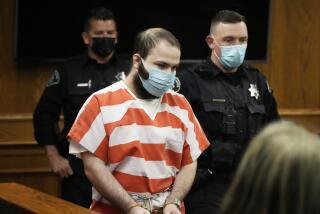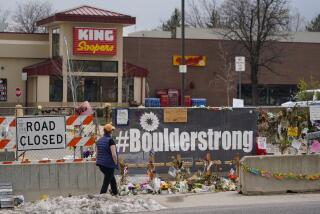Prosecutors in Afghanistan massacre case face tough challenge
- Share via
KABUL, Afghanistan — Most everyone was asleep when an Afghan guard at a U.S. military camp spotted the American soldier walking out the southern gate into the quiet chill of the desert. A general alarm had been sounded by the time he returned and laid his weapon on the ground.
What happened that night, U.S. authorities say, was one of the most horrific massacres of the war in Afghanistan.
Staff Sgt. Robert Bales, a spit-polished and personable veteran of four deployments in Iraq and Afghanistan, is accused of murdering 16 villagers and attempting to kill at least six others. Residents near Camp Belambay said he shot and stabbed people as they rose sleepily from their beds, dragged one woman by her hair and leveled his weapon at a shrieking baby’s mouth.
“It was a mess of blood, ashes and burnt clothes,” said Mohammed Wazir, who returned from out of town with his youngest son later that morning to find the rest of his family — his mother, wife, six other children, brother, sister-in-law and nephew — all dead.
“It took half an hour to identify everyone. All of the bodies were burnt,” Wazir said. He was one of several villagers who traveled to Kabul, the Afghan capital, recently to recount what happened during the three-hour rampage outside Camp Belambay.
On Monday, the Army’s investigation will unfold at Joint Base Lewis-McChord near Seattle in a two-week hearing to determine whether there is sufficient evidence to hold the 3rd Stryker Brigade staff sergeant for a court-martial on charges of premeditated murder, which could carry the death penalty. The hearing will be conducted in part by video link to allow Afghan witnesses to testify from the other side of the world.
The case presents a challenge to Army prosecutors, who must link Bales, 36, to a crime scene and victims even though U.S. forensic investigators were given limited access. Afghan survivors have already expressed little confidence in the military legal system and balked at having some crucial witnesses testify.
“Hang him. That’s what I want. Hang him from the neck; let him dangle,” Wazir said. “Let him sit in front of us. Let him look in our eyes. And we will look in his eyes.”
The slayings took place in southern Afghanistan in two remote farming villages, small clusters of mud brick houses surrounded by fields of pomegranates and grapes. Although the U.S. troop buildup has brought a measure of stability to southern cities, it has failed to offer much protection in the countryside.
Villagers live in fear of the Taliban as well as the Afghan army and U.S. forces, whose skirmishes play out on their narrow, dusty roads. Days before the massacre, villagers said, American troops had angrily questioned nearby residents after a roadside bomb blew off the leg of a friend of Bales.
Shortly after Bales’ arrest, Defense Secretary Leon E. Panetta said the staff sergeant was believed to have left the special operations camp in the early morning of March 11, fired on several families, returned to the base and “basically turned himself in, told individuals what happened.”
Authorities subsequently said they believed Bales made two trips outside the base that night: one to Alkozai, north of Camp Belambay, one to Najiban, about 1 1/2 miles south.
It is unclear how much physical evidence there will be at the hearing. Families almost immediately buried the bodies as dictated by Islamic tradition, making it difficult for medical examiners to positively identify them and match bullet wounds to a weapon.
Prosecutors could face a situation similar to what happened after the 2005 shootings of 24 civilians in Haditha, Iraq. None of the eight Marines charged ever went to jail, in part because of the lack of physical evidence, said Gary Myers, a defense lawyer in that case.
“Bodies could not be examined, crime scenes were not readily available to be viewed,” he said. “It’s a prosecutorial nightmare when you can’t generate the forensic evidence necessary to link the alleged perpetrator to the crime.”
Yet the Army doesn’t have to definitively prove all 16 deaths to win a conviction, said Eugene Fidell, a former military prosecutor and defense counsel who now teaches military justice at Yale Law School. “Certainly there have been cases … where murder convictions have been obtained where no body was found,” he said.
Another question is whether witnesses will be able to identify Bales. Most of those who saw the shooter are dead. The survivors appear to be women — whose male relatives have been reluctant to allow them to testify, even by video — and children.
Two youths who survived the massacre described the horror in detail to the Los Angeles Times, but their description of the killer, whom they called “the American,” remained vague.
“I saw the man in the door and my grandmother crying and screaming,” said a teenager named Rafiullah, who, like many Afghans, uses only one name. Rafiullah said he, his sister and grandmother ran next door and joined several others at the home of Haji Naim.
“The room was a mess, everyone was screaming.... Haji Naim stood up and demanded what is going on. And the American shot him,” he said. “We were seven people in the room when we were shot. My grandmother, my sister, me, two of Haji Naim’s kids and two of Haji Nizar’s kids.”
The youth swept his hand in front of him as if raking a room with gunfire. “He used a pistol,” he said. Four people, including Rafiullah’s grandmother, died in Alkozai. Six people, among them Rafiullah and his sister, were injured.
On his second foray, the gunman rampaged first through Wazir’s house in Najiban and then burst into the home of Mohammed Daoud on the outskirts. He was muttering “Taliban, Taliban” as he pulled Daoud out of his bed, said Daoud’s 10-year-old son, Hikmatullah Gul, who hid under a blanket.
He said his father was calling “Have mercy!” before he was shot. “There was so much blood from my father,” he said. “But the American came again and tore everything apart. Broke windows. Threw a closet to the floor.... The whole house cried.”
Both youths described seeing bright lights outside the houses during the attacks. Some villagers talked of seeing multiple soldiers, but U.S. authorities said they probably saw troops who descended on the hamlets to investigate the attacks.
Bales, a father of two who lived in a two-story home near Lake Tapps, Wash., will probably not undergo much psychological scrutiny during the hearing. His lawyer, John Henry Browne, said it was obvious he was competent to stand trial. Yet the issue of whether he was mentally incapacitated, perhaps because of long-standing stress from four combat deployments, could play a crucial role if the case goes to a court-martial.
Browne said a military mental health review board would perform an evaluation sometime after the hearing and probably consider among other things Bales’ use of steroids, which have been linked anecdotally in other cases to episodes of increased aggression.
The more immediate issues will probably focus on whether Bales made any statements to fellow soldiers that might be seen as a confession, and how firmly Army investigators can link Bales to specific victims.
The defense lawyer also is compiling a “mitigation package” that will detail several traumatic incidents Bales suffered during his previous deployments. One of them, Browne said, resembles a true incident, retold in the 2007 film “In the Valley of Elah,” in which U.S. soldiers ran over an Iraqi child. “It deeply affected him; it profoundly affected him,” he said.
It is not possible, Browne has said, to pass judgment on what Bales did or didn’t do in time of war without also looking at what the war did to Bales.
“I believe we all have a responsibility to Sgt. Bales, and to all these soldiers,” he said. “They’re trying to do the impossible. I’ve got six clients right now that are all Afghanistan veterans, all of whom are in trouble with the law in varying degrees of severity.”
The U.S. government has paid families $50,000 for each death and $10,000 for each of those injured, but villagers say money is scant compensation.
“If your child dies, what would you expect? Money? No,” said Wazir, who denied taking the compensation. “Will you expect prison? We don’t want prison.... If the court doesn’t go the way we want, we will not accept the decision of the court.”
Only one family is left in the area of Alkozai where Rafiullah lived; he and his grandfather moved to another village. Najiban is a ghost town; residents fled, fearing the Americans and the Taliban. Wazir has moved 2 1/2 hours away to live with his brother in Spin Buldak. He and the others are still haunted by the killings.
Rafiullah said: “I see his face in my dreams, and sometimes I hear my sister waking up at the same time, screaming. I am praying every night, please God don’t make this happen again.”
Parker reported from Kabul and Murphy from Seattle. Times staff writer David S. Cloud in Washington contributed to this report.
More to Read
Sign up for Essential California
The most important California stories and recommendations in your inbox every morning.
You may occasionally receive promotional content from the Los Angeles Times.










